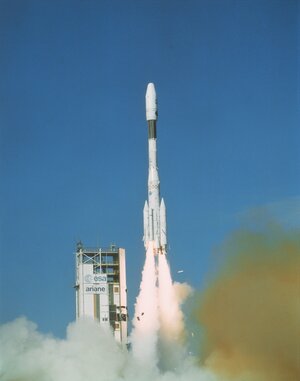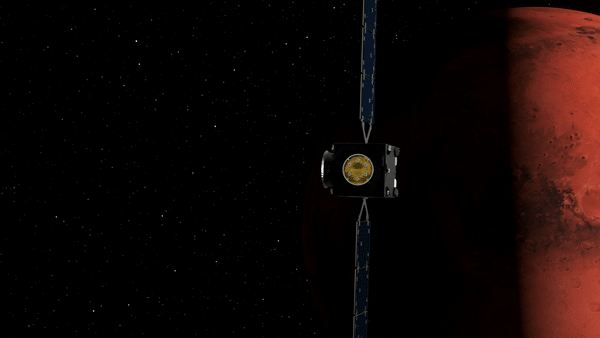Accept all cookies Accept only essential cookies See our Cookie Notice

About ESA
The European Space Agency (ESA) is Europe’s gateway to space. Its mission is to shape the development of Europe’s space capability and ensure that investment in space continues to deliver benefits to the citizens of Europe and the world.
Highlights
ESA - United space in Europe
This is ESA ESA facts Member States & Cooperating States Funding Director General Top management For Member State Delegations European vision European Space Policy ESA & EU Responsibility & Sustainability Annual Report Calendar of meetings Corporate newsEstablishments & sites
ESA Headquarters ESA ESTEC ESA ESOC ESA ESRIN ESA EAC ESA ESAC Europe's Spaceport ESA ESEC ESA ECSAT Brussels Office Washington OfficeWorking with ESA
Business with ESA ESA Commercialisation Gateway Law at ESA Careers Cyber resilience at ESA IT at ESA Newsroom Partnerships Merchandising Licence Education Open Space Innovation Platform Integrity and Reporting Administrative Tribunal Health and SafetyMore about ESA
History ESA Historical Archives Exhibitions Publications Art & Culture ESA Merchandise Kids Diversity ESA Brand Centre ESA ChampionsLatest
Space in Member States
Find out more about space activities in our 23 Member States, and understand how ESA works together with their national agencies, institutions and organisations.
Science & Exploration
Exploring our Solar System and unlocking the secrets of the Universe
Go to topicAstronauts
Missions
Juice Euclid Webb Solar Orbiter BepiColombo Gaia ExoMars Cheops Exoplanet missions More missionsActivities
International Space Station Orion service module Gateway Concordia Caves & Pangaea BenefitsLatest
Space Safety
Protecting life and infrastructure on Earth and in orbit
Go to topicAsteroids
Asteroids and Planetary Defence Asteroid danger explained Flyeye telescope: asteroid detection Hera mission: asteroid deflection Near-Earth Object Coordination CentreSpace junk
About space debris Space debris by the numbers Space Environment Report In space refuelling, refurbishing and removingSafety from space
Clean Space ecodesign Zero Debris Technologies Space for Earth Supporting Sustainable DevelopmentLatest
Applications
Using space to benefit citizens and meet future challenges on Earth
Go to topicObserving the Earth
Observing the Earth Future EO Copernicus Meteorology Space for our climate Satellite missionsCommercialisation
ESA Commercialisation Gateway Open Space Innovation Platform Business Incubation ESA Space SolutionsLatest
Enabling & Support
Making space accessible and developing the technologies for the future
Go to topicBuilding missions
Space Engineering and Technology Test centre Laboratories Concurrent Design Facility Preparing for the future Shaping the Future Discovery and Preparation Advanced Concepts TeamSpace transportation
Space Transportation Ariane Vega Space Rider Future space transportation Boost! Europe's Spaceport Launches from Europe's Spaceport from 2012Latest

Ariane rockets 1 through 5
Thank you for liking
You have already liked this page, you can only like it once!
The first Ariane launcher blasted into the sky on Christmas Eve, 1979. An early Christmas present for the thousands of workers throughout Europe and at Europe’s Spaceport in Kourou who were involved in its development and production.
Ariane 1 was designed primarily to put two telecommunications satellites at a time into orbit, thus reducing costs. As the size of the satellites grew Ariane 1 began to give way to the more powerful Ariane 2 and Ariane 3 launchers.
Altogether, there were 24 successful launches from the first Ariane 1 launching in 1979 to the final Ariane 3 in 1989.
All three launchers were slightly different. The first and third stages of Ariane 2 and Ariane 3 were longer than those of Ariane 1, while Ariane 3 had strap-on boosters containing liquid or solid propellant, making it the most flexible and powerful of the three launchers, capable of launching a payload of 1.7 tonnes.
Ariane 4 was justly known as the ‘workhorse’ of the Ariane family. Since its first flight on 15 June 1988 until the last, on 15 February 2003, it made 113 successful launches. The Ariane 4 proved ideal for launching communications and Earth observation satellites as well as those for scientific research.
This launcher was extremely versatile. The first stage could hold two or four strap-on boosters, or none at all. This meant that it could lift into orbit satellites weighing from 2000 to nearly 4300 kg in GTO, nearly three times as much as the Ariane 3 launcher.
Ariane 5 was Europe’s principal launch system for more than a quarter century, flying 117 times between 1996 and 2023 from Europe’s Spaceport in French Guiana.
This heavy launcher more than doubled the mass-to-orbit capacity of Ariane 4, which flew from 1988 until 2003. Like its predecessor, Ariane 5 was a favourite of the telecommunications industry with its need to put large payloads into very high geosynchronous orbits. With its increased capacity, Ariane 5 was able to orbit two large telecommunications satellites on a single launch, or to push very large payloads into deep space.
-
CREDIT
ESA/CNES/ARIANESPACE - D. Ducros -
LICENCE
ESA Standard Licence

Ariane 4 rocket configurations and an Ariane 5 gener…

First Ariane 4 launch

Ariane 6 and Vega-C artist's views

Connecting Ariane 6 stages















 Germany
Germany
 Austria
Austria
 Belgium
Belgium
 Denmark
Denmark
 Spain
Spain
 Estonia
Estonia
 Finland
Finland
 France
France
 Greece
Greece
 Hungary
Hungary
 Ireland
Ireland
 Italy
Italy
 Luxembourg
Luxembourg
 Norway
Norway
 The Netherlands
The Netherlands
 Poland
Poland
 Portugal
Portugal
 Czechia
Czechia
 Romania
Romania
 United Kingdom
United Kingdom
 Slovenia
Slovenia
 Sweden
Sweden
 Switzerland
Switzerland
























